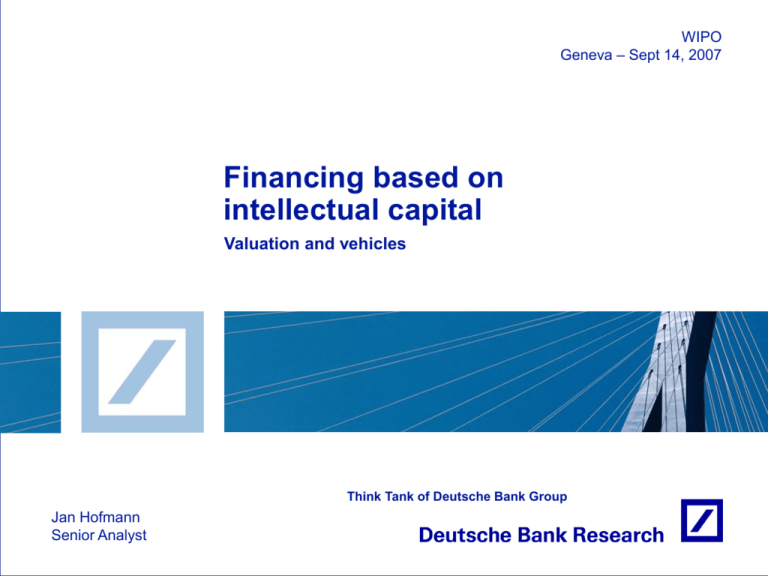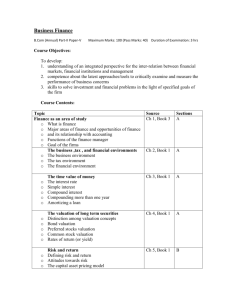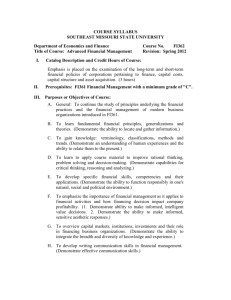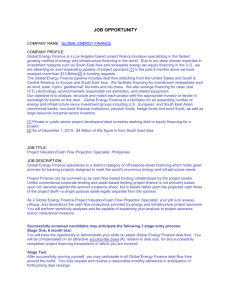
WIPO
Geneva – Sept 14, 2007
Financing based on
intellectual capital
Valuation and vehicles
Think Tank of Deutsche Bank Group
Jan Hofmann
Senior Analyst
IC-based financing
A minor role…
… for commercial banks in financing very young, high growth SMEs?
For high growth SMEs in early phases, debt financing is rarely suitable
High default risks would yield unacceptable interest rates, volumes are often too small
Many commercial banks focus on debt instead of equity financing
especially regarding SMEs
Thus: Today, in many cases: Yes*.
* See also OECD (2005). Intellectual property as an economic
asset: Key issues in valuation and exploitation.
… for IP/IC valuation in banks? No, not at all.
(IP = Intellectual Property, IC = Intellectual Capital)
Jan Hofmann · Sept 14, 2007 · page 2
IC-based financing
Agenda
A
Valuation of intellectual property (IP) and intellectual capital (IC)
B
Vehicles for IP/IC-based financing
Jan Hofmann · Sept 14, 2007 · page 3
IC-based financing
No valuation, no financing
Thus: If ever more successful companies thrive on
their intellectual capital*…
… we have to value it in a broader fashion
human capital, e.g.
• employees‘ skills
• patents
* intellectual capital =
the complete set of a company’s intangibles:
structural capital, e.g.
• processes
relationship capital, e.g.
• customer knowledge
• partner networking
Jan Hofmann · Sept 14, 2007 · page 4
IC-based financing
Chicken and egg problem
Typical chicken and egg problem…
Companies: Why report, if capital market does not appreciate IC reporting?
Capital market / banks: Why learn to evaluate IC, if hardly anybody reports it?
… but gradually more movement on all fronts
Governments: sponsoring development of reporting frameworks/guidelines
Companies: increasing number of pioneers publish IC reports
Capital market / banks: joint actions to foster reporting/valuation,
in Europe e. g. at
– Action group for German financial sector (IFD)
– Working group in Italian financial analysts society (AIAF)
– Commission on Intellectual Capital of EFFAS
Jan Hofmann · Sept 14, 2007 · page 5
IC-based financing
Commission on Intellectual Capital (CIC) @ EFFAS
Main aims of the CIC
Consistent positioning of EFFAS regarding IC valuation and reporting
Identification and bundling of IC expertise of European financial analysts
Overview of the initiatives and experiences in US, Europe and Asia
Development of excellence network with major experts world-wide
www.effas.com/en/commissions.htm
Jan Hofmann · Sept 14, 2007 · page 6
IC-based financing
Build on IP-based financing
(IP = Intellectual Property, IC = Intellectual Capital)
Financing based on…
Build on experience in
IP valuation
Use IP-based products
to acclimatise
investors to intangibles
… intellectual
capital
… intellectual
property
Jan Hofmann · Sept 14, 2007 · page 7
IC-based financing
IP valuation
Monetary valuation
Non-monetary valuation
All three “classic” approaches used
Usually broad set of indicators
used
Income, cost, market
More recently also econometric
methods used
enabling efficient valuation of large patent
portfolios
A lot of real world experience
breadth of protection, legal security,
holders human ressources to capitalise
IP etc.
Mainly for internal IP
management
Econometric models used, too
for academic and political purposes
often combined
Jan Hofmann · Sept 14, 2007 · page 8
IC-based financing
IC valuation – monetary yardstick needed?
Monetary valuation
Non-monetary valuation
Only “income approach” used
Broad set of indicators used
“Cost approach” rarely makes sense for
intangibles, “market approach” lacks
sufficiently liquid and transparent market
which should be company-specific?
Worthwhile only if benchmarked
be it with companies’ own historical
values or those of other companies
Many assumptions to be made
Possible without inside knowledge
Little real world experience
Is complex, usually needs inside
knowledge
Laborious finding, filtering, assessing and
integrating process
but see e. g. Baruch Lev’s “Intangibles
Scoreboard” as IC valuation example
Growing real world experience
combine?
Jan Hofmann · Sept 14, 2007 · page 9
IC-based financing
Agenda
A
Valuation of intellectual property (IP) and intellectual capital (IC)
B
Vehicles for IP/IC-based financing
Jan Hofmann · Sept 14, 2007 · page 10
IC-based financing
Evolution of IP/IC-based financing vehicles
Credit ratings will further embrace IP (and later IC) valuation
Basel II might help
Equity analysts will broaden their IC/IP valuation
Analysts societies envision extension of their training
More and more mergers and acquisitions are all about IC/IP
Just look at the prices paid recently for internet community site companies
Bundling IP in funds, securitising IP are growing markets
and IP valuation the prerequisite
And much of this should be beneficial for knowledge-intensive SMEs.
Jan Hofmann · Sept 14, 2007 · page 11
IC-based financing
Example 1
IC/IP-embracing credit rating (I)
A possible – if costly – procedure would be to:
1.
Identify and analyse (only) those intangibles of particular relevance to
the company-specific value-added process
In doing so, (a) gear the approach to a proven method of (non-monetary) IC valuation,
and (b) try to condense them into one single indicator (in a systematic way)
2.
Analyse the transmission mechanisms that transform those pivotal
intangibles into future revenues
Are internal training and external networking synchronised with the R&D roadmap?
Is the roadmap conducive to the realisation of the general corporate strategy? Etc.
3.
Re-use this pattern for follow-up ratings
The analysis profile developed in (1) and (2) can be applied again, decreasing average costs
These three steps can complement the classic credit risk review
but would make new/adapted business models necessary
Jan Hofmann · Sept 14, 2007 · page 12
IC-based financing
Example 1
IC/IP-embracing credit rating (II)
The use of IC valuation in credit rating…
… is simplified, as credit ratings and methods are confidential
Reduces the IC rating acceptance problem to a bank-internal one
… is fostered by Basel II
if only moderately
IC/IP-enhanced credit rating as a competitive edge for lenders…
Broader market; credit pricing better attuned to risk than that of competitors
… fostering debt financing for knowledge-intensive SMEs?
Jan Hofmann · Sept 14, 2007 · page 13
IC-based financing
Example 2
Patent funds
Products hit the market in recent years
Level of sophistication is rising
Latest examples: “Patent Select I, II”
Patent Select I, II
(Deutsche Bank, Clou Partners)
– sophisticated patent selection process
(starting from very large candidate pool)
– 12 patents (or patent families) acquired
– patents to be refined by fund
(development of prototypes etc.)
– closed fund, finite duration (appr. 6 years)
Jan Hofmann · Sept 14, 2007 · page 14
IC-based financing
Example 3
Securitisation of IP (I)
A young business can sell (part of) its future IP-related earnings:
Immediate access to cash with an only moderate loss of control to
external agents, but…
… a young and still (very) small market
… for the moment, only diversified patent portfolios will be marketable
… investors will demand a high market success probability
Jan Hofmann · Sept 14, 2007 · page 15
IC-based financing
Example 3
Securitisation of IP (II)
The market is still young and mostly opaque – but promising:
Securitised intangibles
Securitisations of future income backed by intangible assets
Issuer
Assets
Value (USD)
Year
David Bow ie
James Brow n
DreamWorks
DreamWorks
Guess?
Royalty Pharma*
Athlete’s Foot
Dunkin’ Brands
Music rights
Music rights
Film rights
Film rights
Brand rights
Pharmaceutical patents
Franchising/brand rights
Franchising/brand rights**
55 m
30 m
1 bn
1 bn
75 m
225 m
30-50 m
1.7 bn
1997
1999
1997
2002
2003
2003
2003
2006
* Earlier securitisation of an individual patent failed owing to lack of diversification
** Includes a minor share of rights to tangible assets
Sources: The Pullman Group, Washington Core
Jan Hofmann · Sept 14, 2007 · page 16
IC-based financing
Thank you for your attention
jan-p.hofmann@db.com
Jan Hofmann · Sept 14, 2007 · page 17
IC-based financing
© Copyright 2007. Deutsche Bank AG, DB Research, D-60262 Frankfurt am Main, Germany. All rights reserved. When quoting please cite
“Deutsche Bank Research”.
The above information does not constitute the provision of investment, legal or tax advice. Any views expressed reflect the current views of the
author, which do not necessarily correspond to the opinions of Deutsche Bank AG or its affiliates. Opinions expressed may change without
notice. Opinions expressed may differ from views set out in other documents, including research, published by Deutsche Bank. The above
information is provided for informational purposes only and without any obligation, whether contractual or otherwise. No warranty or
representation is made as to the correctness, completeness and accuracy of the information given or the assessments made.
In Germany this information is approved and/or communicated by Deutsche Bank AG Frankfurt, authorised by Bundesanstalt für Finanzdienstleistungsaufsicht. In the United Kingdom this information is approved and/or communicated by Deutsche Bank AG London, a member of
the London Stock Exchange regulated by the Financial Services Authority for the conduct of investment business in the UK. This information is
distributed in Hong Kong by Deutsche Bank AG, Hong Kong Branch, in Korea by Deutsche Securities Korea Co. and in Singapore by Deutsche
Bank AG, Singapore Branch. In Japan this information is approved and/or distributed by Deutsche Securities Limited, Tokyo Branch. In
Australia, retail clients should obtain a copy of a Product Disclosure Statement (PDS) relating to any financial product referred to in this report
and consider the PDS before making any decision about whether to acquire the product.
Jan Hofmann · Sept 14, 2007 · page 18
IC-based financing
Appendix
Jan Hofmann · Sept 14, 2007 · page 19
IC-based financing
Reasons to value intellectual capital
Companies’ perspective:
… to improve short-term ressource allocation and long-term
investment strategies, to improve external communication with
various stakeholders
talent, partners, sponsors (and investors, of course)
Investors’ and lenders’ perspective:
… to optimize investment and lending portfolios
by investing/lending even better in line with risk
Economies’ perspective:
… to strengthen growth
by channelling capital more reliably to most efficient users, by making capital markets
less volatile, by reducing information asymmetries in capital markets
Jan Hofmann · Sept 14, 2007 · page 20
IC-based financing
IC valuation –
a combined
model…
Short version
Full version
Identification and non-monetary valuation
of the company‘s intangible assets
Non-monetary
valuation
Monetary
valuation
e.g. with Intangibles
Scoreboard (see text)
Improves earnings forecast and estimate of discount rate
Forecast of future
intangible-driven earnings
(IDE)
Forecast of future overallproject earnings
Discounted with IDE
risk-adjusted rate
Discounted with project riskadjusted rate
Company‘s total intangibles
Net present value of the
knowledge-intensive project
Deviation of indicators for
price forecast
Calculation of the monetary
net present value of the
company‘s total intangible
assets
Calculation of the monetary
net present value of
individual projects
(knowledge-intensive)
Jan Hofmann · Sept 14, 2007 · page 21
Strictly external valuation possible
Internal participation necessary
e.g. with Holistic
Value Approach,
method of the „Arbeitskreis Wissensbilanz“
(see text)
© DB Research
Analysis of the transmission mechanisms
intangible assets future earnings
IC-based financing
… applied to specific valuation purposes
Full version
Short version
Identification and non-monetary valuation
of the company‘s intangible assets
Analysis of the transmission mechanisms
intangible assets future earnings
Improves earnings forecast and estimate of discount rate
Forecast of future
intangible-driven earnings
(IDE)
Forecast of future overallproject earnings
Discounted with IDE
risk-adjusted rate
Discounted with project riskadjusted rate
Company‘s total intangible
capital
Credit rating
― Monetary valuation
not necessary
M&A, major investment
― Monetary valuation
decisive
― Full version of
non-monetary
valuation (usually)
too costly
― Non-monetary
preparation possible
owing to close contact
with the company
Minor/medium-sized
investment
― Monetary valuation
desired
In-house planning
― Monetary valuation
customary
Net present value of the
knowledge-intensive project
Deviation of indicators for
share price forecast
Calculation of the monetary
net present value of the
company‘s total intangible
assets
Strictly external valuation possible
Calculation of the monetary
net present value of
individual projects
(knowledge-intensive)
Internal participation necessary
Jan Hofmann · Sept 14, 2007 · page 22
― Information for
non-monetary
valuation often not
available
― Full version of nonmonetary valuation
sensible, as it can be
put to many uses








